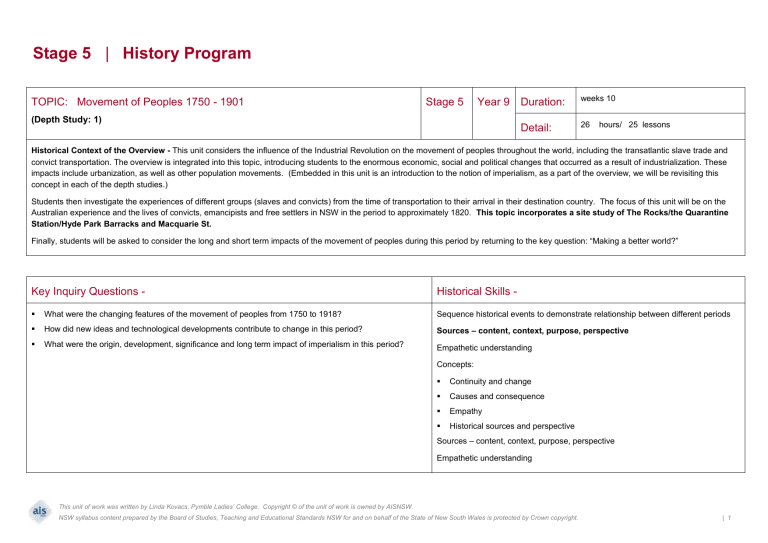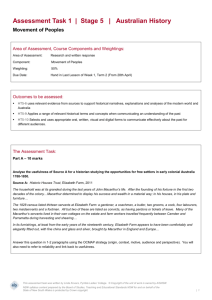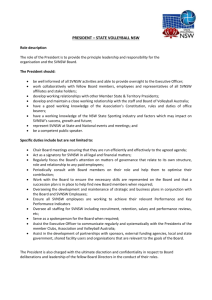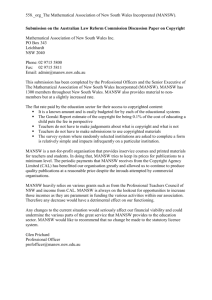Movement of Peoples 1750 - 1901 - Association of Independent

Stage 5
|
History Program
TOPIC: Movement of Peoples 1750 - 1901
(Depth Study: 1)
Stage 5 Year 9 Duration:
weeks 10
Detail:
26 hours/ 25 lessons
Historical Context of the Overview This unit considers the influence of the Industrial Revolution on the movement of peoples throughout the world, including the transatlantic slave trade and convict transportation. The overview is integrated into this topic, introducing students to the enormous economic, social and political changes that occurred as a result of industrialization. These impacts include urbanization, as well as other population movements. (Embedded in this unit is an introduction to the notion of imperialism, as a part of the overview, we will be revisiting this concept in each of the depth studies.)
Students then investigate the experiences of different groups (slaves and convicts) from the time of transportation to their arrival in their destination country. The focus of this unit will be on the
Australian experience and the lives of convicts, emancipists and free settlers in NSW in the period to approximately 1820. This topic incorporates a site study of The Rocks/the Quarantine
Station/Hyde Park Barracks and Macquarie St.
Finally, students will be asked to consider the long and short term impacts of the movement of peoples during this period by returning to the key question: “Making a better world?”
Key Inquiry Questions -
What were the changing features of the movement of peoples from 1750 to 1918?
How did new ideas and technological developments contribute to change in this period?
What were the origin, development, significance and long term impact of imperialism in this period?
Historical Skills -
Sequence historical events to demonstrate relationship between different periods
Sources – content, context, purpose, perspective
Empathetic understanding
Concepts:
Continuity and change
Causes and consequence
Empathy
Historical sources and perspective
Sources – content, context, purpose, perspective
Empathetic understanding
This unit of work was written by Linda Kovacs, Pymble Ladies’ College. Copyright © of the unit of work is owned by AISNSW.
NSW syllabus content prepared by the Board of Studies, Teaching and Educational Standards NSW for and on behalf of the State of New South Wales is protected by Crown copyright. | 1
Framing Questions
–
Why did people leave their homes for the Americas and Australia?
How did new ideas/ideologies impact upon the 19th C
How has the movement of peoples during this period impacted upon our world today? Has it made a better world?
Concepts:
Continuity and change
Causes and consequence
Empathy
Historical sources and perspective
Outcomes
A student:
HT5 1 explains and assesses the historical forces and factors that shaped the modern world and Australia
HT5 2 sequences and explains the significant patterns of continuity and change in the development of the modern world and Australia
HT5 4 explains and analyses the causes and effects of events and developments in the modern world and Australia
HT5 6 uses relevant evidence from sources to support historical narratives, explanations and analyses of the modern world and Australia
HT5 9 applies a range of relevant historical terms and concepts when communicating an understanding of the past
HT5 10 selects and uses appropriate oral, written, visual and digital forms to communicate effectively about the past for different audiences
Historical Concepts
The following historical concepts are integrated into the lesson sequences:
Revolution
Imperialism
Transportation
Trans-Atlantic slave trade
Abolitionism
Key Historical Terms & Concepts -
Continuity and change
Causes and consequence
Empathy
Historical sources and perspective
Site Study
Colonial Australia
– the Rocks, Hyde Park Barracks and the Quarantine Station
This unit of work was written by Linda Kovacs, Pymble Ladies’ College. Copyright © of the unit of work is owned by AISNSW.
NSW syllabus content prepared by the Board of Studies, Teaching and Educational Standards NSW for and on behalf of the State of New South Wales is protected by Crown copyright. | 2
Skills:
Sequence historical events to demonstrate relationship between different periods
Terms and concepts
Sources
– content, context, purpose, perspective
Empathetic understanding
Resources Resources
Books –
Pearson History 9 , Ailing Coughlin (ed.), Australia 2012 and Student Workbook 9
Pearson History 10 , Ailing Coughlin (ed.), Australia 2012 and Student Workbook 10
The Making of the Modern World , (9) P Ashton - M Anderson, (Macmillan, 2012)
History Alive 10 , R. Darlington, (Wiley and Sons, 2012) and Student Workbook 10
History 9 for the Australian Curriculum , A Woollacott (ed.) , (Cambridge, 2012)
Websites –
http://www.bbc.co.uk/bitesize/ks3/history/industrial_era/the_industrial_revolution/revision/5/
http://www.historylearningsite.co.uk/
http://www.historylearningsite.co.uk/WORLD%20WAR%20TWO.htm
http://www.records.nsw.gov.au/state-archives/indexes-online/indexes-to-convict-records
http://www.records.nsw.gov.au/state-archives/indexes-online/indexes-to-convict-records
http://www.liverpoolmuseums.org.uk/ism/
History 10 for the Australian Curriculum , A Woollacott (ed.) , (Cambridge, 2012)
Big Ideas, Australian curriculum 10 , G Carrodus et. al., (Oxford, 2012) and Student Workbook
The Modern World and Australia , (10) P Ashton - M Anderson, (Macmillan, 2012)
The Atlas of Human Migration – Global Patterns of People on the Move , (J King and C Lacey eds., Earthscan, UK, 2010)
Human Odyssey , Xavier Rizos & Annabel Astbury, (HTAV, Collingwood Vic. 2012)
Atlas of the Transatlantic Slave Trade , D Eltis and D Richardson, (Yale University, 2010)
You Tube Clips –
Horrible Histories – life during the Industrial Revolution, transportation
Hans Rosling clip ‘200 yrs. in 4 mins’ http://www.youtube.com/watch?v=jbkSRLYsojo
DVD: Armistad ‘The Middle Passage’ http://www.youtube.com/watch?v=mXS6JAhMe1Q
DVDs
–
DVD: Worst Jobs in History
– the Industrial Revolution
DVD: Who Do You Think You Are? Jason Donovan
Video: The African Trade
This unit of work was written by Linda Kovacs, Pymble Ladies’ College. Copyright © of the unit of work is owned by AISNSW.
NSW syllabus content prepared by the Board of Studies, Teaching and Educational Standards NSW for and on behalf of the State of New South Wales is protected by Crown copyright. | 3
Assessment overview Depth Study 1b
The Movements of People
Assessment as learning
Semester 1
Term 2, Week 1
Assessment of learning Assessment for learning
Timeline: Inventions of the Industrial Age. Students research one invention each and then combine to form a timeline.
Emphasis is on the effect each one had. Students make their own timeline of 10 of these inventions.
Girls write a response to question ‘To what extent was this period truly revolutionary?’. There is a PEEL paragraph scaffold that may be used for this question.
PowerPoint Working Conditions: information and video clips.
Girls then research one group and report back to class. They are given scenarios and have to empathize as to what they would do.
Weighting: 50%
Area of Assessment: Research and written response using sources
Outcomes: HT 5-6, HT5- 9, HT5-10
Content
Overview: The overview is integrated into this topic, introducing students to the enormous economic, social and political changes that occurred as a result of industrialization. These impacts include urbanization, as well as other population movements.
(Embedded in this unit is an introduction to the notion of imperialism, as a part of the overview, we will be revisiting this concept in each of the depth studies.)
Teaching and learning strategies Resources
Students:
Are introduced to the concept of Revolution, specifically the Industrial Revolution
(ACDSEH018)
outline the key features of the Industrial
Revolution in Britain
explain how the agricultural revolution caused
British people to move from villages to towns and cities to create a cheap labour force
1. What is a “revolution”? – Students to brainstorm their understanding of the term revolution.
Identify different types of revolutions: political, social, industrial, technological Terms and concepts . Think pair share activity .
(UG2) Key features of the Revolution and the changes that it brought about?
2. visual activity showing the change from a predominately rural to an urban society
Using the Internet and their text book, in groups of 4, students create a word web around the words “Industrial Revolution”. This is to be followed with discussion and feedback.
Complete activities from Pearson workbook 9, pages 26
– 28 (Why did the Revolution occur)
This unit of work was written by Linda Kovacs, Pymble Ladies’ College. Copyright © of the unit of work is owned by AISNSW.
NSW syllabus content prepared by the Board of Studies, Teaching and Educational Standards NSW for and on behalf of the State of New South Wales is protected by Crown copyright.
Pearson History 9 , Aisling
Coughlin (ed.), Australia 2012 and
Student Workbook 9
Pearson History 10 , Aisling
Coughlin (ed.), Australia 2012 and
Student Workbook 10
The Making of the Modern World ,
(9) P Ashton - M Anderson,
(Macmillan, 2012)
History Alive 10 , R. Darlington,
| 4
Content Teaching and learning strategies Resources
3. Assessment for Learning: Timeline: Inventions of the Industrial Age. Students research one invention each and then combine to form a timeline. Emphasis is on the effect each one had.
Students then make their own timeline of 10 of these inventions.
Students are
introduced to the nature and significance of the
Industrial Revolution and how it affected living and working conditions, including within Australia
4.
Complete the summary activity on the UK school history website. Some things change, some stay the same: http://www.historylearningsite.co.uk/industrial_revolution_towns.htm
using this website, students make notes on life in the town during the period. Make a table showing the things that remain the same today and the things that have changed.
5 Source analysis – Responses to Invention and Change.
Discussion: how can we account for this?
6. PowerPoint Life in Industrial cities.
7. Using evidence (activity optional?)
8. Summative assessment: Making a better world? Activity Life before and after the
Revolution: Line of significance using visual sources
10. Introduce and practice PEEL Paragraph writing.
Assessment for learning: (Homework task)
Girls wr ite a response to the question “To what extent was this period truly revolutionary?”
11. Significance of the Industrial Revolution
Read text on impacts, students watch Hans Rosling clip ‘200 yrs in 4 mins’. And discuss the questions. Go back to the questi on “Making a better world?” – Students evaluate the positives and the negatives and then write a response.
How did the Industrial Revolution impact upon/encourage European nationalism and imperialism?
How did the Industrial Revolution impact upon/encourage European nationalism and imperialism?
Students to complete background reading from section 2.5 (pages 65 - 67) on Imperialism
Introduction to the key concepts of nationalism and imperialism and 2.6 (page 71) on nationalism. Having read the text complete a Colour, Symbol, Image activity for the concepts of imperialism and nationalism.
Students to use the internet to collect three sources per group which demonstrate/explain British imperialism in action. They are to report briefly to the class on which sources they chose and why.
Mapping exercise - students to use their Jacaranda atlas p 152 - 153 to locate the British empire.
Complete associated activities.
(Wiley and Sons, 2012) and Student
Workbook 10
History 9 for the Australian
Curriculum , A Woollacott (ed.) ,
(Cambridge, 2012)
History 10 for the Australian
Curriculum , A Woollacott (ed.) ,
(Cambridge, 2012)
Big Ideas, Australian curriculum
10 , G Carrodus et. al., (Oxford,
2012) and Student Workbook
The Modern World and
Australia , (10) P Ashton - M
Anderson, (Macmillan, 2012)
DVD: Worst Jobs in History
– the
Industrial Revolution http://www.youtube.com/watch?v=jb kSRLYsojo
Jacaranda atlas pages 154 - 155
Text: Retroactive and the Jacaranda
World Atlas sections: 3.2, 3.3, 3.4
This unit of work was written by Linda Kovacs, Pymble Ladies’ College. Copyright © of the unit of work is owned by AISNSW.
NSW syllabus content prepared by the Board of Studies, Teaching and Educational Standards NSW for and on behalf of the State of New South Wales is protected by Crown copyright. | 5
Content
Students:
outline how the Industrial Revolution influenced transportation of convicts to Australia and the migration of free settlers
identify the movement of slaves out of Africa and the movement of convicts and free settlers out of
Britain
The experiences of slaves, convicts and free settlers upon departure, their journey abroad, and their reactions on arrival, including the Australian experience (ACDSEH083)
Teaching and learning strategies
(UG3) Why did people leave their homes for the Americas and Australia?
Visual diagram ‘Why do people leave their homes’ introducing the three different reasons: migration, slavery & convict transportation. Students define each as a class.
Introduction to Slavery. Read the Retroactive chapter on slavery and define – the Middle
Passage, slave traders, plantation system.
View video to introduce the concept of slavery: complete work sheet or view a short 6min clip from Amistad.
Discuss and define – the Middle Passage, slave traders, plantation system.
Mapping exercise to track movement of slaves and convicts. (p24 -27 and p34
– 35) Provide students with a blank map.
Use the Museum of Slavery and/or the Digital History Atlas to trace the triangle trade. Complete the activity sheet
Activity from page 199 of Human Odyssey “Phone a friend?”
Summary (revisit) What events influenced the movement of peoples around the world?
Complete the activity “Evaluate” on page123 of Oxford Big Ideas 9
Resources
Atlas of the Transatlantic Slave
Trade , D Eltis and D Richardson,
(Yale University, 2010)
Video: The African Trade
Oxford Big Ideas 9 , Geraldine
Carrodus et al, (Oxford 2012
DVD: Armistad ‘The Middle
Passage’ http://www.youtube.com/watch?v=m
XS6JAhMe1Q
Jacaranda atlas pages 154 - 155 http://www.liverpoolmuseums.org.uk/ ism/
Atlas of the Transatlantic Slave
Trade , D Eltis and D Richardson,
(Yale University, 2010)
Students:
investigate the main features of slavery, including transportation
select an individual slave sent to the Americas, or a convict or a free settler who came to Australia and use sources to construct the story of their experiences
use a variety of sources to investigate and report on the changing way of life of ONE of the following:
- convicts
(UG3) How can we gain an understanding of the different experiences people had during this time?
(using primary source materials to create a picture of the past)
Source work lesson focusing on using primary sources.
Students use the map and table of statistics provided (p198 HO) to identify the number of slaves transported and the places involved. They identify the natural and human resources used to advance some countries economically (link back to Industrial Rev.)
Reasons for transportation. Students research the different types of crimes that led to transportation.
Convict Life in Sydney Cove worksheet and Retroactive activities.
A Day in the Life of a Convict. Students examine aspects of daily life in Port Jackson through
The Atlas of Human Migration –
Global Patterns of People on the
Move , (J King and C Lacey eds.,
Earthscan, UK, 2010)
Human Odyssey , Xavier Rizos &
Annabel Astbury, (HTAV,
Collingwood Vic. 2012) http://www.records.nsw.gov.au/statearchives/indexes-online/indexes-toconvict-records
JKs PowerPoint on Sydney
Landscapes
This unit of work was written by Linda Kovacs, Pymble Ladies’ College. Copyright © of the unit of work is owned by AISNSW.
NSW syllabus content prepared by the Board of Studies, Teaching and Educational Standards NSW for and on behalf of the State of New South Wales is protected by Crown copyright. | 6
Content
Students:
Changes in the way of life of a group(s) of people who moved to Australia in this period, such as free settlers on the frontier in Australia
(ACDSEH084)
Teaching and learning strategies
written and audio sources. Complete table.
Transportation a new start: Students research the lives of 5 different convicts and examine their achievements in the new colony. Using the The Australian Dictionary of Biography
Critical thinking lesson: PowerPoint on ‘leaden hearts’ reliability of primary sources enquiry and line of significance activity
Extension Activity: essay question:
Why were women sent to the colony
– for crimes or for breeding?
Additional Resources for this section:
Retroactive 1b:4 or p.150. www.hht.net.au
Audio sources.
The Australian Dictionary of Biography http://adb.anu.edu.au
http://www.records.nsw.gov.au/state-archives/indexes-online/indexes-to-convict-records
SITE STUDY
– The Rocks, Harbour Cruise, Quarantine Station, Hyde Park Barracks.
Parramatta .
Students to feedback on different sites
PowerPoint presentation
– Struggling to Survive
Lecture style presentation by FD
Assessment task: source based study
Reading for understanding: students to read information from their text giving general information on the experiences of settlers who moved to Australia in this period. Mind map summary as a group.
SITE STUDY
– The Rocks, Harbour Cruise, Quarantine Station, Hyde Park Barracks.
Parramatta Female factory, Elizabeth Farm.
Students to feedback on different sites in class discussion. Students discuss the differences
Resources
Documentary The Floating Brothel http://www.australianhistory.org/conv icts http://australia.gov.au/aboutaustralia/australian-story/convictsand-the-british-colonies
M Anderson, (Macmillan, 2012)
History 9 for the Australian
Curriculum , A Woollacott (ed.) ,
(Cambridge, 2012) http://www.gould.com.au/Free-
Settlers-of-Australia-1788-1828p/don033.htm
http://www.hht.net.au/museums/eliza beth_farm http://www.hht.net.au/discover/highli ghts/guidebooks/elizabeth_farm
H arbour Foreshore Authority
Pearson History 9 , Aisling
Coughlin (ed.), Australia 2012 and
Student Workbook 9
The Making of the Modern World ,
(9) P Ashton - M Anderson,
(Macmillan, 2012)
History 9 for the Australian
Curriculum , A Woollacott (ed.) ,
This unit of work was written by Linda Kovacs, Pymble Ladies’ College. Copyright © of the unit of work is owned by AISNSW.
NSW syllabus content prepared by the Board of Studies, Teaching and Educational Standards NSW for and on behalf of the State of New South Wales is protected by Crown copyright. | 7
Content
describe the impact of convicts and free settlers on the Indigenous peoples of the regions occupied
The short- and long-term impacts of the movement of peoples during this period
(ACDSEH085)
Students:
describe both the immediate and longer-term consequences of transporting African slaves to the Americas
assess the impact of convicts and free settlers on the development of the Australian nation
Teaching and learning strategies Resources
between convicts, settlers, women etc.
Assessment task: Discuss how life differed for various groups in the early colonial period in
Sydney 1788 – 1850. In your answer you need to refer to at least two groups in the colony and include two primary sources from own research.
Impact of colonial settlement on Indigenous Australians. PowerPoint presentation – Struggling to
Survive . Lecture style presentation. Students complete worksheets.
Teacher exposition on the Black Wars of Resistance. Class discussion of key primary sources. http://www.hht.net.au/museums/eliza beth_farm http://www.hht.net.au/discover/highli ghts/guidebooks/elizabeth_farm
Enquiry question: Was Pemulwuy the first resistance fighter? Source based enquiry.
(UG4) How has the movement of peoples during this period impacted upon our world today?
Visual representation which summarizes key points and allows students to view the positive and negative features of migration in the 18th and 19th centuries. Class discussion from after viewing
‘Who do you think you are’.
H arbour Foreshore Authority
Summary (revisit) What events influenced the movement of peoples around the world?
Evaluation:
Students to fill in a table of the ‘push’ and pull’ factors accounting for the movements of peoples 1750 – 1901 compared with the movements of people today.
Here now/There then exercise used to generate a class discussion about the changing values and judgments surrounding migration/slavery/convict transportation.
(Cambridge, 2012) http://www.gould.com.au/Free-
Settlers-of-Australia-1788-1828p/don033.htm
These materials have been developed by the AIS through funding provided by the NSW Government to support new syllabus implementation. Copyright is owned by AISNSW.
Except as set out below or permitted under the Copyright Act, no part may be reproduced, stored or communicated without the approval of AISNSW.
Not for profit organisations may reproduce, store in a retrieval system and communicate the whole or any part of the materials without payment of a fee or other remuneration provided: a) The institution does not sell, hire or otherwise derive revenue from such reproduction, storage or communication b) The copyright of AISNSW is noted on any part which is copied or noted
If any other licence is sought, inquiries should be directed to the Executive Director of AISNSW.
This unit of work was written by Linda Kovacs, Pymble Ladies’ College. Copyright © of the unit of work is owned by AISNSW.
NSW syllabus content prepared by the Board of Studies, Teaching and Educational Standards NSW for and on behalf of the State of New South Wales is protected by Crown copyright. | 8
Teaching and Learning Program Evaluation
Program or Unit Title : ___________________________________________________________ Class: ________________ Teacher: _____________________________________
Element
Program
Was the program well-structure and coherent?
To what extent did the program engage all students in the class?
Did the program assist all students to achieve the learning outcomes?
What improvements could be made?
Evaluation
Resources
Were the resources used appropriately in terms of age level, variety and the ability to engage the students?
What improvements could be made?
Assessment
Did the program incorporate a range of quality, valid assessment tasks?
Reflect and comment on the level of student achievement in this program.
What improvements could be made to assist students to achieve the outcomes?
Date Commenced : ____________________________ Date Completed : _____________________________ Signature: _________________________________________
This unit of work was written by Linda Kovacs, Pymble Ladies’ College. Copyright © of the unit of work is owned by AISNSW.
NSW syllabus content prepared by the Board of Studies, Teaching and Educational Standards NSW for and on behalf of the State of New South Wales is protected by Crown copyright. | 9








